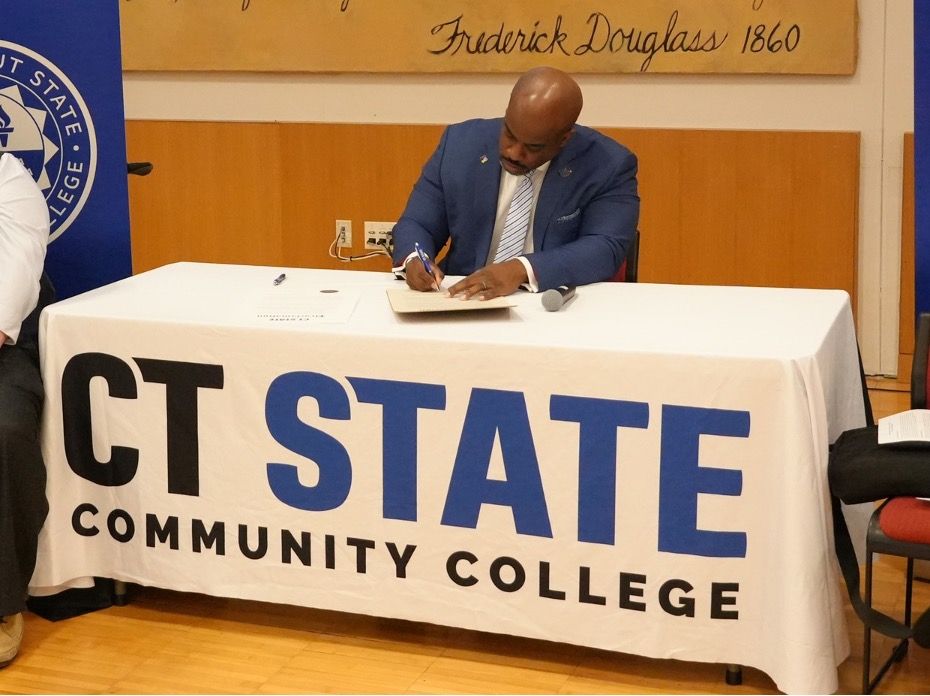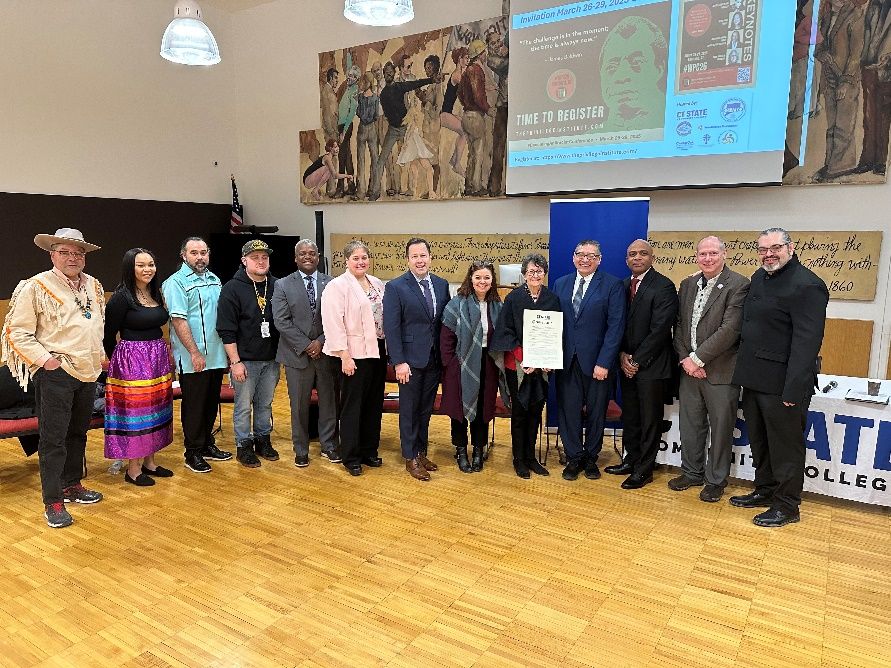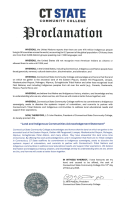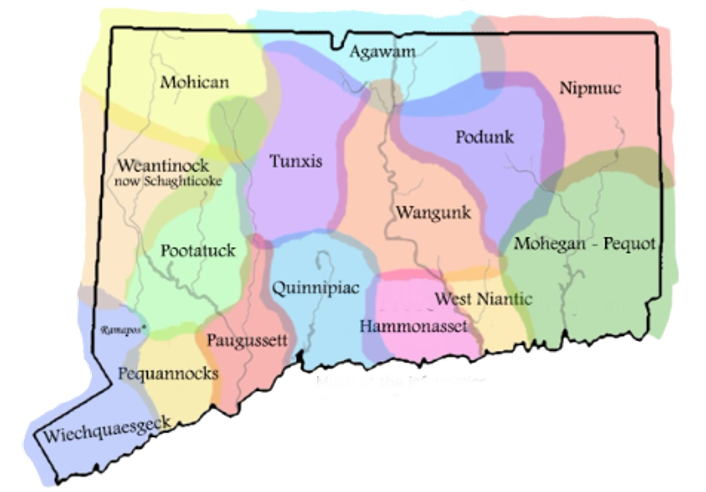Guidance on Using the CT State Land and Indigenous Acknowledgement

On February 19, 2025, President Maduko traveled to CT State Three Rivers, joining elders and chiefs from Indigenous tribes across Connecticut, and signed the CT State Land Acknowledgement. The acknowledgment is an important step in fostering partnership, respect and diversity and it was followed by a community conversation on how CT State can work with the tribes and other Indigenous groups to fulfill the spirit of the land acknowledgment.
CT State Native American and Indigenous Council
The gathering also marked the beginning of the CT State Native American and Indigenous Council (NIC) which will be consolidated in Fall 2025. This volunteer council comprises representatives from tribal and Indigenous communities and CT State Indigenous leaders, faculty, staff and students. The goals of the council are:
- To strengthen the partnership between tribal government, Indigenous communities, and CT State students, faculty and staff from Indigenous and tribal communities.
- To provide advice to the CT State DEI office on best practices that support native and Indigenous students and communities at CT State.
How to use the Land and Indigenous Acknowledgement
Current CT State Equity Statement
Equity is the removal and reduction of barriers that negatively impact student success within structures, and policies and practices by ensuring that students receive targeted resources and support to achieve their academic, professional, and personal goals. Equity is achieved by identifying and intentionally addressing structural racism, systemic poverty, and other forms of marginalization, and upholding the expectation that administrators, faculty, and staff act as anti-racist institutional change agents. CT State commits to bold and disruptive change by actively identifying, naming, and dismantling structural racism, systemic poverty, and other barriers, establishing equitable and anti-racist policies and practices, and empowering students, faculty, staff, and administrators to advance racial, social, and economic justice. Our core collective responsibility is to continuously assess practices and policies and transform the world we live in by eliminating inequities.
Draft Land Recognition Statement
CT State acknowledges and honors that the land on which we gather is the ancestral land of the [Eastern Pequot, Golden Hill Paugussett, Lenape, Mashantucket Pequot, Mohegan, Nipmuc, Schaghticoke Tribal Nation and many others]. They have stewarded this land since time immemorial. By offering this land acknowledgment, and in recognition that there are no tribal colleges in Connecticut, CT State reaffirms its commitment to Indigenous sovereignty, seeks to dissolve the systemic impact of colonialism, and commits to partner with Connecticut’s Tribal Nations and Indigenous communities to address local educational needs and support their aspirations. We believe that Native and Indigenous history, wisdom, and knowledge are key to understanding who we are, where we live, and how we will create a better future together.
**Please note that the tribal names within brackets “[ ]” can be replaced depending on the region of the state. For reference we have listed the names of Connecticut tribes and a map at the end of this document.
A land acknowledgment is a formal institutional statement that recognizes and honors Connecticut’s Native peoples as traditional stewards of the land, and the contribution of Indigenous peoples from all over the world to today’s society. The statement is also a recommitment to partner with Native Tribes and Indigenous communities to address local educational needs and support their aspirations.
All land in the State of Connecticut was once Native territory, which is why it is our honor to acknowledge that CT State and its 30+ sites across Connecticut are located on historical Native land. Land acknowledgments do not exist in the past tense or historical context: colonialism is a current and ongoing process, and thus, we need to build mindfulness of our present participation. It is also worth noting that acknowledging the land is a well-established Indigenous protocol.
The United Nations recognizes more than 370 million Indigenous Peoples worldwide, most of which were dislocated by colonialism in its different iterations. Due to globalization, Connecticut has seen a growth in urban Indians (of many descendants), First Nation (Canada, Australia, New Zealand), and other US (Samoan, Native Hawaiian) and non-US (Maya, Zapotec, Purépecha, Igbo, Tibetans, Uyghurs, Taino, etc.) Indigenous communities which are now part of our community life and contribute each day to our state.
At CT State, the Land Acknowledgement Statement can be read aloud or distributed by students, faculty, or staff, or CT State guests who wish to show their respect at public or private events on college property. We also strongly encourage that the statement be read at official CT State convenings and events such as convocations and graduation ceremonies. When reading the acknowledgment, it is important to “localize” which tribes you are including in the proclamation. Localizing in this context is listing (by replacing the names of tribes or indigenous populations “in red lettering”), with those in your area. We have provided the following guide to support our local campus and sites in localizing the relevant tribes.
History of Indigenous Land Use in Connecticut
Much of the information that this map is based on comes from records written by European colonists who may have assigned inaccurate names to certain tribes due to miscommunication and language differences.
Tribal nations may have called themselves one name and been called something different by other tribes. Other names may have been intended to refer to a single village and ended up applied to an entire tribe, or vice-versa.
Many Algonquian names and words have multiple different spellings because Algonquian was not a written language prior to European contact, and all words were spelled phonetically when they were eventually written down.
Connecticut Tribal Nations (Circa 1600s)
- Agawam
- Hammonasset
- Mohegan - Pequot
- Mohican
- Nipmuc
- Paugussett
- Pequannocks
- Podunk
- Pootatuck
- Quinnipiac
- Ramapos
- Tunxis
- Wangunk
- Weantinock now Schaghticoke
- West Niantic
- Wiechquaesgeck
Key Local English Pronunciations
- Eastern Pequot (Pea-kwaht)
- Golden Hill Paugussett (paw-GUS-it)
- Lenape (Leh-NAH-pay)
- Mashantucket Pequot (Mash-un-tuck-it Pea-kwaht)
- Mohegan (Mo-he-gan)
- Nipmuc (Nip-muck)
- Schaghticoke (ska-teh-COKE)


